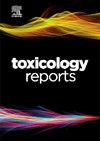The protective role of nicardipine in dextran sulfate sodium-induced colitis in mice: Modulating inflammation and apoptosis
Q1 Environmental Science
引用次数: 0
Abstract
Ulcerative colitis (UC) is a chronic inflammatory bowel disease associated with persistent inflammation, oxidative stress, and epithelial apoptosis. Nicardipine, a dihydropyridine calcium channel blocker, exhibits anti-inflammatory and anti-apoptotic properties, but its therapeutic potential in UC remains unclear. This study evaluated the effects of nicardipine on dextran sulfate sodium (DSS)-induced colitis in mice, focusing on inflammatory, oxidative, and apoptotic pathways. Fifty BALB/c mice were assigned to five groups (n = 10): control, DSS, nicardipine 12 mg/kg, nicardipine 24 mg/kg, and 5-aminosalicylate (ASA) 75 mg/kg. Treatments were administered for 3 days before and 10 days during DSS exposure. Disease severity was assessed by body weight, disease activity index (DAI), and colon length. Colonic mRNA levels of Nlrp3, TNF-α, IL-17, and TNFSF10 were quantified by RT-PCR; protein expression of caspase-3, caspase-8, BAX, and BCL-2 was analyzed by Western blot. Serum malondialdehyde (MDA), myeloperoxidase (MPO), glutathione peroxidase-1 (GPX-1), occludin, and prostaglandin E₂ (PGE-2) were measured by ELISA. Histological scoring assessed epithelial integrity and inflammation. Nicardipine dose-dependently reduced DSS-induced weight loss, DAI, and colon shortening. Both doses significantly downregulated Nlrp3, TNF-α, IL-17, and TNFSF10 (p < 0.05), decreased caspase-3 and BAX, and increased BCL-2. Nicardipine restored GPX-1, lowered MDA and MPO, preserved occludin, and reduced PGE-2. Histology confirmed reduced mucosal injury and preserved epithelial architecture. Nicardipine attenuates DSS-induced colitis by suppressing pro-inflammatory cytokines, reducing oxidative stress, and inhibiting apoptosis, supporting its potential as a therapeutic candidate for UC. Further studies are warranted to clarify its molecular mechanisms and clinical relevance.
尼卡地平对硫酸葡聚糖钠诱导小鼠结肠炎的保护作用:调节炎症和细胞凋亡
溃疡性结肠炎(UC)是一种慢性炎症性肠病,与持续炎症、氧化应激和上皮细胞凋亡有关。尼卡地平是一种二氢吡啶钙通道阻滞剂,具有抗炎和抗凋亡的特性,但其在UC中的治疗潜力尚不清楚。本研究评估尼卡地平对小鼠右旋糖酐硫酸钠(DSS)诱导结肠炎的影响,重点关注炎症、氧化和凋亡途径。50只BALB/c小鼠分为5组(n = 10):对照组、DSS组、尼卡地平12 mg/kg组、尼卡地平24 mg/kg组和5-氨基水杨酸酯(ASA) 75 mg/kg组。分别于DSS暴露前3天和暴露后10天进行处理。通过体重、疾病活动指数(DAI)和结肠长度评估疾病严重程度。RT-PCR法检测Nlrp3、TNF-α、IL-17、TNFSF10 mRNA水平;Western blot检测caspase-3、caspase-8、BAX、BCL-2蛋白的表达。ELISA法检测血清丙二醛(MDA)、髓过氧化物酶(MPO)、谷胱甘肽过氧化物酶-1 (GPX-1)、occludin、前列腺素e2 (PGE-2)水平。组织学评分评估上皮完整性和炎症。尼卡地平剂量依赖性降低dss诱导的体重减轻、DAI和结肠缩短。两种剂量均显著下调Nlrp3、TNF-α、IL-17和TNFSF10 (p < 0.05),降低caspase-3和BAX,升高BCL-2。尼卡地平恢复GPX-1,降低MDA和MPO,保留occludin,降低PGE-2。组织学证实粘膜损伤减轻,上皮结构保留。尼卡地平通过抑制促炎细胞因子、减少氧化应激和抑制细胞凋亡来减轻dss诱导的结肠炎,支持其作为UC治疗候选药物的潜力。需要进一步的研究来阐明其分子机制和临床意义。
本文章由计算机程序翻译,如有差异,请以英文原文为准。
求助全文
约1分钟内获得全文
求助全文
来源期刊

Toxicology Reports
Environmental Science-Health, Toxicology and Mutagenesis
CiteScore
7.60
自引率
0.00%
发文量
228
审稿时长
11 weeks
 求助内容:
求助内容: 应助结果提醒方式:
应助结果提醒方式:


